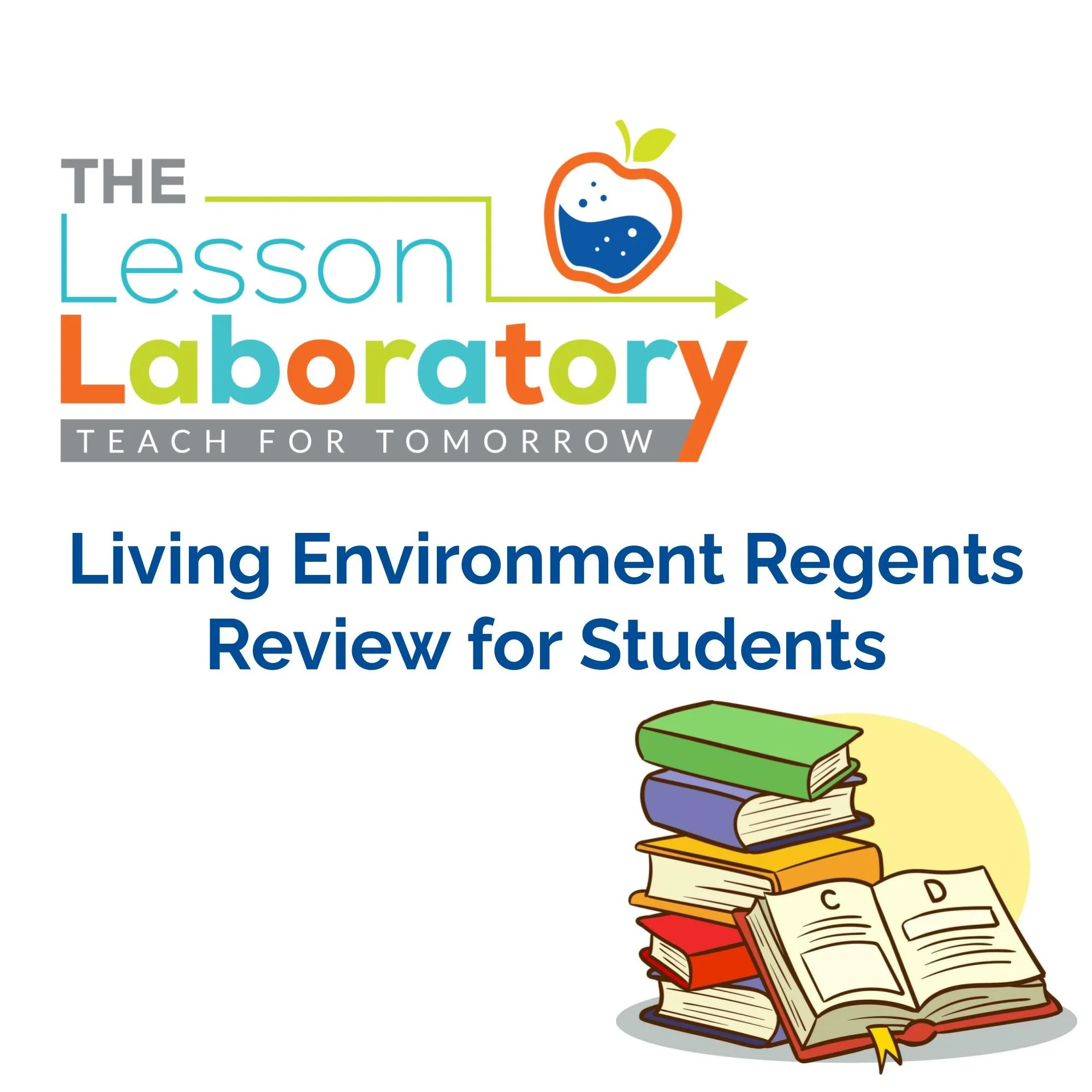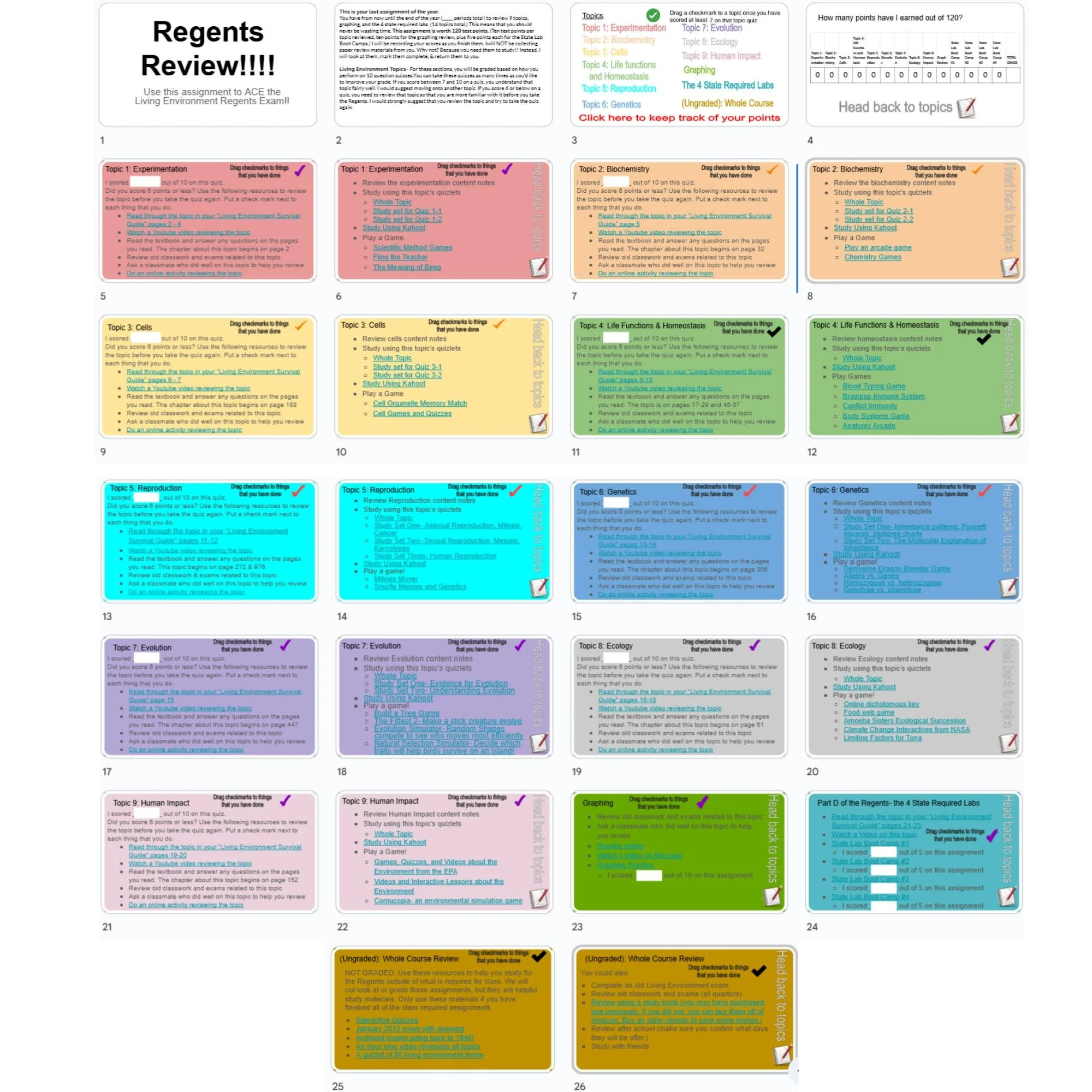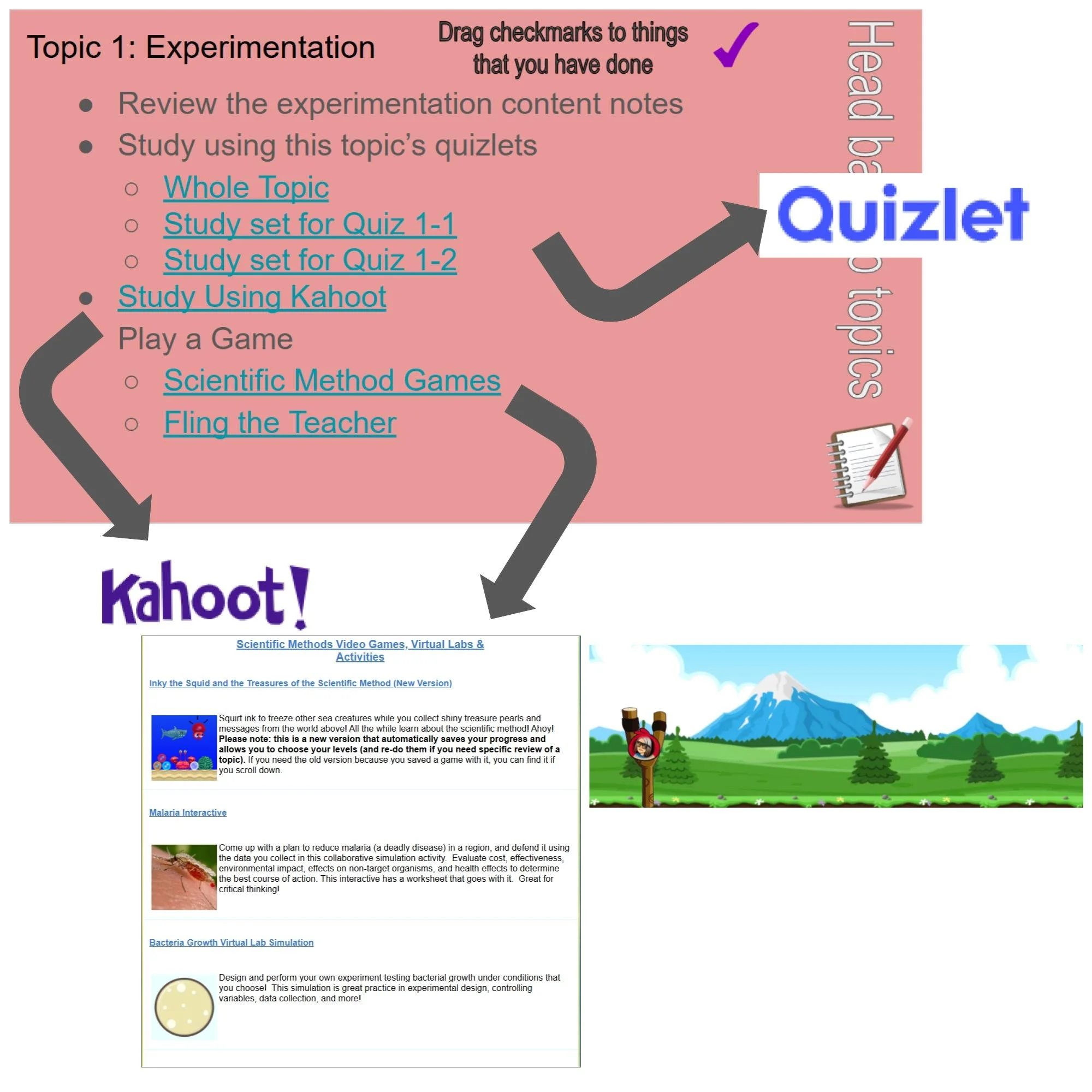



Living Environment Regents Review for Students
Supercharge Your Biology Review with our Comprehensive Study Resource!
🚀 Elevate Your Review Experience: Say goodbye to dull, one-dimensional Regents Review! Dive into a dynamic, hyperlinked Google Slides document that breaks down crucial biology topics into nine digestible sections. Whether you're gearing up for exams or simply hungry for knowledge, this resource has it all!
📚 A Treasure Trove of Resources:
📖 Biology Survival Guide (24 pages)
🎥 Twelve Informative YouTube Videos
🖱️ Eleven Interactive Online Activities
🧠 Twenty-three Quizlets for Reinforcement
🎯 Nine Engaging Kahoot Games for Interactive Learning
🕹️ THIRTY Free Online Educational Games for Immersive Practice
🧪 Four 'State Lab Boot Camps' for In-Depth Lab Review
📝 Access to Archived Regents Exams for Real-World Practice
📖 Learning Reinforced, Strategies Encouraged:
📚 Textbook Integration: Seamlessly aligns with Miller and Levine Biology (editable page numbers for flexibility)
🧾 Classwork and Exam Review: Tap into prior knowledge for a comprehensive grasp of concepts
👥 Peer Collaboration: Leverage the expertise of a high-achieving classmate for enhanced understanding
🗂️ Track Progress Easily: Interactive features like draggable checkmarks, a dedicated grade tracking slide, and hyperlinked navigation ensure a seamless review journey.
🧬 Tailored Learning Experience: Personalize your review process to maximize understanding and retention.
🌐 Unlock Success Today: Whether you're a student gearing up for exams or an educator seeking to enrich your curriculum, this resource is your key to mastering biology. Explore the bundled quizzes for an even more comprehensive study experience.
🌟 Elevate Your Biology Journey: Don't settle for ordinary review methods. Embrace this dynamic resource and transform your students' biology understanding. Happy teaching!
In my class, this is a large, 120 point assignment that counts as a test. I ask them to take a 10 point quiz on the topic as a pre-assessment, to review only those topics that they struggled with, and then to take the 10 point topic quiz again. If you would like my to use my quizzes, they are available for purchase separately or bundled with this assignment. Look for the bundle right here on The Lesson Laboratory!
Grade Recommendation
Grade Level: High School (Grades 9–10)
Course Fit: Living Environment (Biology) — aligns directly with New York State Regents curriculum and NGSS core ideas in life science.
Adaptable For: Advanced 8th-grade accelerated biology programs or review in 11th-grade support classes.
Cross-Curricular Connections and Extensions
Math Integration: Graphing review and quantitative practice strengthen mathematical reasoning skills (interpreting data, analyzing trends).
English Language Arts: Students evaluate multiple resources (articles, videos, and data), engage in informational reading, and synthesize evidence—skills strongly tied to Common Core literacy.
Technology Integration: Students interact with simulations, online quizzes, Kahoots, and BiomanBio digital games, developing digital literacy and self-directed learning strategies.
Extension Option: Students could reflect on personal learning progress or create digital review summaries (infographics, slide decks, or concept maps).
Join the Lesson Laboratory and Teach for Tomorrow!
NGSS Standards (Including CCCs and SEPs)
Because this resource reviews nearly the entire Living Environment curriculum, it connects broadly across multiple NGSS dimensions:
Life Science Disciplinary Core Ideas:
HS-LS1: Structure and Function; Organization for Matter and Energy Flow in Organisms.
HS-LS2: Ecosystem Interactions, Energy, and Dynamics.
HS-LS3: Inheritance and Variation of Traits.
HS-LS4: Biological Evolution: Unity and Diversity.
Representative Performance Expectations:
HS-LS1-2: Develop and use models to illustrate hierarchical organization of interacting systems.
HS-LS2-6: Evaluate claims and evidence that ecosystems maintain consistent numbers and types of organisms under stable conditions.
HS-LS3-1: Ask questions to clarify relationships about the role of DNA and chromosomes in coding instructions for traits.
HS-LS4-2: Construct an explanation based on evidence that evolution results from multiple mechanisms.
Crosscutting Concepts (CCCs):
Cause and Effect: Links between independent/dependent variables, homeostasis, and adaptation.
Systems and System Models: Organ systems, ecological networks, and the biosphere.
Energy and Matter: Flow of energy through living systems.
Stability and Change: Ecosystem balance and genetic variation over time.
Science and Engineering Practices (SEPs):
Analyzing and Interpreting Data: Review of lab data, graphs, and state lab activities.
Developing and Using Models: Simulations of genetic inheritance, ecological balance, and homeostasis.
Engaging in Argument from Evidence: Students justify conclusions on review quizzes and labs.
Obtaining, Evaluating, and Communicating Information: Synthesizing multiple media formats for review.
Common Core Standards
Because this review incorporates multimedia resources, written reflection, and data analysis, it aligns with multiple Common Core ELA and Math standards:
ELA/Literacy:
CCSS.ELA-LITERACY.RST.9-10.1: Cite specific textual evidence to support analysis of science and technical texts.
CCSS.ELA-LITERACY.RST.9-10.7: Integrate quantitative or technical information expressed in words with a version expressed visually.
CCSS.ELA-LITERACY.WHST.9-10.2: Write informative/explanatory texts to convey scientific information clearly.
Math:
CCSS.MATH.PRACTICE.MP4: Model with mathematics (graphing section and data interpretation).
CCSS.MATH.CONTENT.HSS-ID.A.1: Represent data with plots on the real number line (dot plots, histograms, box plots).
Supercharge Your Biology Review with our Comprehensive Study Resource!
🚀 Elevate Your Review Experience: Say goodbye to dull, one-dimensional Regents Review! Dive into a dynamic, hyperlinked Google Slides document that breaks down crucial biology topics into nine digestible sections. Whether you're gearing up for exams or simply hungry for knowledge, this resource has it all!
📚 A Treasure Trove of Resources:
📖 Biology Survival Guide (24 pages)
🎥 Twelve Informative YouTube Videos
🖱️ Eleven Interactive Online Activities
🧠 Twenty-three Quizlets for Reinforcement
🎯 Nine Engaging Kahoot Games for Interactive Learning
🕹️ THIRTY Free Online Educational Games for Immersive Practice
🧪 Four 'State Lab Boot Camps' for In-Depth Lab Review
📝 Access to Archived Regents Exams for Real-World Practice
📖 Learning Reinforced, Strategies Encouraged:
📚 Textbook Integration: Seamlessly aligns with Miller and Levine Biology (editable page numbers for flexibility)
🧾 Classwork and Exam Review: Tap into prior knowledge for a comprehensive grasp of concepts
👥 Peer Collaboration: Leverage the expertise of a high-achieving classmate for enhanced understanding
🗂️ Track Progress Easily: Interactive features like draggable checkmarks, a dedicated grade tracking slide, and hyperlinked navigation ensure a seamless review journey.
🧬 Tailored Learning Experience: Personalize your review process to maximize understanding and retention.
🌐 Unlock Success Today: Whether you're a student gearing up for exams or an educator seeking to enrich your curriculum, this resource is your key to mastering biology. Explore the bundled quizzes for an even more comprehensive study experience.
🌟 Elevate Your Biology Journey: Don't settle for ordinary review methods. Embrace this dynamic resource and transform your students' biology understanding. Happy teaching!
In my class, this is a large, 120 point assignment that counts as a test. I ask them to take a 10 point quiz on the topic as a pre-assessment, to review only those topics that they struggled with, and then to take the 10 point topic quiz again. If you would like my to use my quizzes, they are available for purchase separately or bundled with this assignment. Look for the bundle right here on The Lesson Laboratory!
Grade Recommendation
Grade Level: High School (Grades 9–10)
Course Fit: Living Environment (Biology) — aligns directly with New York State Regents curriculum and NGSS core ideas in life science.
Adaptable For: Advanced 8th-grade accelerated biology programs or review in 11th-grade support classes.
Cross-Curricular Connections and Extensions
Math Integration: Graphing review and quantitative practice strengthen mathematical reasoning skills (interpreting data, analyzing trends).
English Language Arts: Students evaluate multiple resources (articles, videos, and data), engage in informational reading, and synthesize evidence—skills strongly tied to Common Core literacy.
Technology Integration: Students interact with simulations, online quizzes, Kahoots, and BiomanBio digital games, developing digital literacy and self-directed learning strategies.
Extension Option: Students could reflect on personal learning progress or create digital review summaries (infographics, slide decks, or concept maps).
Join the Lesson Laboratory and Teach for Tomorrow!
NGSS Standards (Including CCCs and SEPs)
Because this resource reviews nearly the entire Living Environment curriculum, it connects broadly across multiple NGSS dimensions:
Life Science Disciplinary Core Ideas:
HS-LS1: Structure and Function; Organization for Matter and Energy Flow in Organisms.
HS-LS2: Ecosystem Interactions, Energy, and Dynamics.
HS-LS3: Inheritance and Variation of Traits.
HS-LS4: Biological Evolution: Unity and Diversity.
Representative Performance Expectations:
HS-LS1-2: Develop and use models to illustrate hierarchical organization of interacting systems.
HS-LS2-6: Evaluate claims and evidence that ecosystems maintain consistent numbers and types of organisms under stable conditions.
HS-LS3-1: Ask questions to clarify relationships about the role of DNA and chromosomes in coding instructions for traits.
HS-LS4-2: Construct an explanation based on evidence that evolution results from multiple mechanisms.
Crosscutting Concepts (CCCs):
Cause and Effect: Links between independent/dependent variables, homeostasis, and adaptation.
Systems and System Models: Organ systems, ecological networks, and the biosphere.
Energy and Matter: Flow of energy through living systems.
Stability and Change: Ecosystem balance and genetic variation over time.
Science and Engineering Practices (SEPs):
Analyzing and Interpreting Data: Review of lab data, graphs, and state lab activities.
Developing and Using Models: Simulations of genetic inheritance, ecological balance, and homeostasis.
Engaging in Argument from Evidence: Students justify conclusions on review quizzes and labs.
Obtaining, Evaluating, and Communicating Information: Synthesizing multiple media formats for review.
Common Core Standards
Because this review incorporates multimedia resources, written reflection, and data analysis, it aligns with multiple Common Core ELA and Math standards:
ELA/Literacy:
CCSS.ELA-LITERACY.RST.9-10.1: Cite specific textual evidence to support analysis of science and technical texts.
CCSS.ELA-LITERACY.RST.9-10.7: Integrate quantitative or technical information expressed in words with a version expressed visually.
CCSS.ELA-LITERACY.WHST.9-10.2: Write informative/explanatory texts to convey scientific information clearly.
Math:
CCSS.MATH.PRACTICE.MP4: Model with mathematics (graphing section and data interpretation).
CCSS.MATH.CONTENT.HSS-ID.A.1: Represent data with plots on the real number line (dot plots, histograms, box plots).